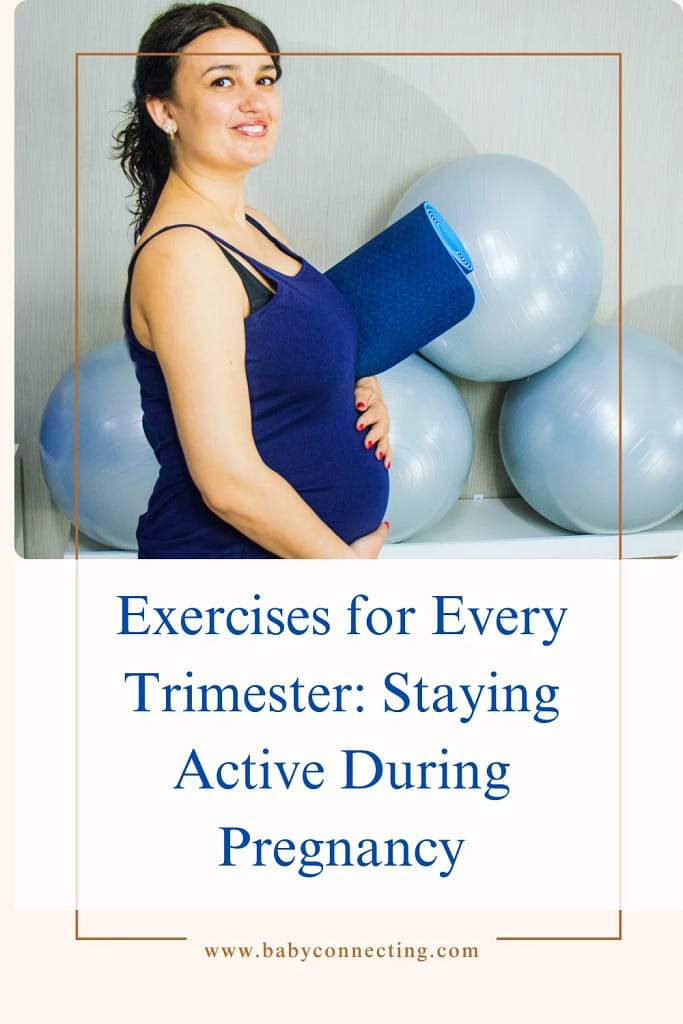Exercises for Every Trimester: Staying Active During Pregnancy
Pregnancy is a transformative journey that comes with numerous physical and emotional changes. Staying active during pregnancy is not only beneficial for the health of the mother but also plays a vital role in the development of the baby. Regular exercise can help manage pregnancy symptoms such as back pain, fatigue, and swelling, improve circulation, and promote mental well-being. However, it’s essential to adjust your workout routine according to the trimester and the changes your body undergoes throughout the nine months.
This comprehensive guide will help you understand how to stay active during pregnancy, offering trimester-specific exercises to ensure both you and your baby remain healthy and strong. Whether you’re a seasoned fitness enthusiast or new to exercise, you can incorporate safe and effective movements into your daily routine. Let’s explore the benefits of staying active during pregnancy and dive into trimester-specific exercises.

1. The Benefits of Exercise During Pregnancy
Exercise during pregnancy offers a multitude of benefits for both the mother and the baby. Here’s how staying active can improve your pregnancy experience:
Improves Physical Health
Physical activity during pregnancy helps boost circulation, reduces the risk of gestational diabetes, and helps prevent excess weight gain. Regular exercise supports your cardiovascular health, which is vital for both you and your baby.
Reduces Pregnancy Discomfort
Pregnancy can come with aches and pains, such as back pain, swollen feet, and joint discomfort. Exercise helps relieve these symptoms by strengthening muscles and improving flexibility. It also helps prevent or alleviate issues like constipation and bloating.
Enhances Mental Well-being
Exercise stimulates the release of endorphins, which help reduce stress, anxiety, and depression. Physical activity during pregnancy can also improve your mood and give you a sense of accomplishment and vitality.
Improves Sleep Quality
Staying active during pregnancy can improve sleep quality by reducing the discomforts that interfere with restful sleep, such as leg cramps and back pain. A regular exercise routine can also make it easier to fall asleep and stay asleep.
Prepares for Labor
Regular physical activity, especially strengthening exercises for the pelvic floor and core, can help prepare your body for labor. Studies have shown that women who stay active during pregnancy tend to have shorter labor and recovery times.

2. Exercise Guidelines During Pregnancy
Before starting any exercise routine during pregnancy, it’s essential to consult with your healthcare provider, especially if you have any pre-existing medical conditions or complications. Once you have the go-ahead, there are some general guidelines to follow:
Stay Hydrated
It’s important to stay hydrated during exercise, especially during pregnancy. Dehydration can lead to complications such as preterm labor or dizziness. Drink plenty of water before, during, and after your workout.
Listen to Your Body
Pregnancy is not the time to push through intense discomfort or pain. If you feel dizzy, short of breath, or faint, stop immediately and rest. Always listen to your body’s signals and adjust your workouts accordingly.
Focus on Low-Impact Exercises
During pregnancy, it’s best to focus on low-impact exercises to reduce the strain on your joints and avoid injury. Swimming, walking, and cycling are excellent low-impact options.
Avoid Exercises That Involve Lying on Your Back
As your pregnancy progresses, avoid exercises that involve lying on your back for extended periods. This position can decrease circulation to your baby and may cause discomfort.
Modify As You Go
Your body will change over the course of your pregnancy, so your exercise routine should change as well. What feels good during the first trimester may need to be modified in the second or third trimesters as your body adjusts to its growing size and shape.

3. First Trimester Exercises (Weeks 1-12)
The first trimester is often marked by significant hormonal changes, fatigue, and morning sickness. Many women experience nausea, exhaustion, and a heightened sense of smell during this phase, which can make it more difficult to stay active. However, exercising during this time is crucial for setting the tone for a healthy pregnancy.
Walking
Walking is a great way to get moving during the first trimester. It’s gentle on your body, improves circulation, and helps prevent constipation. Aim for 20-30 minutes of brisk walking every day. If you’re feeling fatigued, it’s okay to start with shorter walks and gradually increase the duration.
Prenatal Yoga
Prenatal yoga is a wonderful exercise option for early pregnancy, as it focuses on gentle stretching, breathing, and relaxation techniques. Yoga can help improve flexibility, reduce stress, and relieve common early pregnancy discomforts such as back pain and fatigue.
Recommended Poses: Cat-Cow Stretch, Child’s Pose, and Seated Forward Fold.
Tip: Always opt for prenatal yoga classes or videos, as they are tailored to the needs of pregnant women.
Swimming
Swimming is one of the best low-impact exercises, especially during early pregnancy. The buoyancy of water reduces the pressure on your joints, and the full-body workout helps increase strength and stamina. Swimming or water aerobics can also help relieve swelling and discomfort.
Benefits: Low-impact, improves circulation, and supports the weight of your growing baby.
Pelvic Floor Exercises (Kegels)
Strengthening your pelvic floor muscles is essential throughout pregnancy. Kegels help improve bladder control, prevent pelvic organ prolapse, and prepare your body for labor. Start by contracting the muscles you would use to stop urination, hold for 5 seconds, and then release. Aim for 10-15 repetitions per session.
4. Second Trimester Exercises (Weeks 13-26)
The second trimester is often referred to as the “honeymoon” phase of pregnancy. Many women experience relief from early pregnancy symptoms like morning sickness and fatigue, and they may start to feel more energized. The body is also more accustomed to the changes occurring, which makes it a great time to increase the intensity of your workouts (while still staying within safe limits).
Cycling (Stationary or Outdoor)
Cycling is a safe and effective way to stay active in the second trimester. If you enjoy outdoor cycling, be cautious and avoid rough terrain or high-risk areas. Stationary bikes provide a low-impact cardio workout that strengthens the legs and improves cardiovascular health.
Benefits: Improves heart health, builds lower body strength, and provides a controlled, low-risk workout.
Strength Training
Strength training during pregnancy can help tone muscles, reduce back pain, and increase endurance. Focus on light weights and high repetitions, and avoid heavy lifting or exercises that strain your joints. Ensure that you use proper form to prevent injury.
Recommended Exercises: Bodyweight squats, bicep curls with light weights, and lunges.
Tip: Always perform strength exercises with controlled, slow movements, and avoid exercises that require balancing on one leg.
Prenatal Pilates
Prenatal Pilates is a great way to strengthen your core muscles, improve posture, and support your growing belly. Pilates exercises focus on controlled movements that target specific muscle groups while improving flexibility and balance.
Recommended Exercises: Pelvic tilts, leg lifts, and modified planks.
Tip: Avoid exercises that require lying flat on your back or excessive twisting.
Walking with a Mild Incline
As your energy levels increase, consider incorporating a mild incline into your walking routine to make it more challenging. Walking on an incline helps tone the lower body, strengthens your legs, and increases cardiovascular endurance.
5. Third Trimester Exercises (Weeks 27-40)
The third trimester is when your body is preparing for labor, and the physical changes may begin to feel more pronounced. You may experience discomforts such as lower back pain, swelling, and difficulty sleeping. Staying active during this trimester can help ease these symptoms and prepare your body for the demands of labor and delivery.
Walking
Walking remains an excellent low-impact exercise choice, even during the third trimester. It’s easy to modify the pace depending on how you’re feeling, and it helps maintain circulation and alleviate swelling in the legs and feet. Walking also helps relieve tension in the lower back and hips.
Benefits: Eases swelling, improves circulation, and prepares the body for labor.
Squats
Squats help strengthen the pelvic muscles, legs, and core, which are essential for supporting the weight of your growing baby and preparing for labor. Squats also help open up the pelvis and improve flexibility, which may ease the delivery process.
How to Perform: Stand with your feet shoulder-width apart, bend your knees, and lower your hips as though you’re sitting in a chair. Keep your back straight and chest up. Return to standing and repeat.
Modified Side-Lying Leg Lifts
Side-lying leg lifts help strengthen the glutes, legs, and hips without putting pressure on the back. These exercises are great for improving stability and preventing muscle imbalances as your body grows.
How to Perform: Lie on your side with your legs stacked. Lift your top leg towards the ceiling and lower it slowly. Perform 10-12 repetitions on each side.
Breathing and Relaxation Techniques
As labor approaches, practicing breathing exercises and relaxation techniques can help reduce stress and anxiety. Deep breathing, visualization, and meditation are excellent ways to stay calm and focused during the third trimester.
Recommended Practice: Practice slow, deep breathing through your nose, allowing your abdomen to expand with each breath. This helps oxygenate your body and relax the muscles.
6. Conclusion
Staying active during pregnancy is an important aspect of maintaining both your physical and mental well-being. By choosing the right exercises for each trimester and making modifications as your body changes, you can help reduce discomfort, improve your strength and flexibility, and prepare your body for labor. Whether you enjoy walking, swimming, yoga, or strength training, the key is to listen to your body, stay consistent, and consult your healthcare provider for any concerns.
By incorporating regular exercise into your pregnancy routine, you’ll not only enhance your overall pregnancy experience but also pave the way for a smoother postpartum recovery. Keep moving, stay healthy, and embrace the changes your body is going through as you nurture both yourself and your growing baby.


